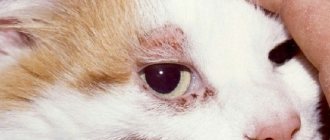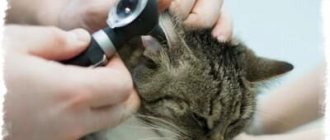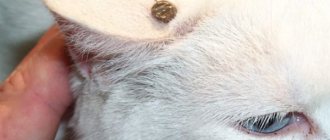If your indoor cat is clearly bothered by his ears, the most likely cause of the discomfort may be otodectosis, which is caused by mites. In this case, the pet requires immediate help. Infection with ear parasites dramatically reduces the quality of life of an animal and can even lead to its death. You will learn how to identify the symptoms of the disease and what medications to successfully treat it from our article.
Features of the disease
Otodecosis in cats is caused by the microscopic (about ½ mm) insect Otodectes cynotus.
The parasite has a whitish oval body and jointed limbs. It loves moisture and warmth, so it parasitizes inside the animal’s ear canal, feeding on skin scales, blood, and lymph. Outside the host's body, the tick can live for about two months. In most cases, the parasite affects both ears of the cat. The likelihood of infection is especially high during the warm and humid seasons - spring and early autumn. The risk group includes kittens under one year old and weakened animals. It may take several years from the moment of infection to obvious signs of the presence of a tick. The disease manifests itself especially clearly when a bacterial infection is added to the skin damage by the parasite. Due to itching and pain, an exhausted pet cannot sleep or eat.
Pathogen information
Ticks of the genus Otodectes cynotis are found in cats, dogs, ferrets, and foxes. They parasitize on the skin of the ears on the inside and in the external auditory canal. Parasites feed on particles of exfoliated skin in the ear, as well as the lymph and blood of the host.
Ear mites are very small and quite difficult to see with the naked eye:
- an adult male Otodectes cynotis measures 0.27 to 0.36 mm in length;
- females are slightly larger - from 0.34 to 0.45 mm.
On a dark background, they look like light moving oval-shaped dots of a light yellow hue. Ear mites in cats have well-developed limbs and a strong gnawing mouthpart.
The duration of the life cycle of Otodectes cynotis depends on environmental conditions. Outside the cat’s body, the parasite can live for about 22 days if the thermometer does not rise above 7 degrees Celsius and the air humidity is between 85–93%.
At subzero temperatures, ear mites die within 5 days. The full development cycle of the parasite in cats takes about 3–4 weeks.
The danger of ear mites for cats
Ear mites feed on skin particles, causing severe damage to the skin. If left untreated, your cat may develop serious health problems:
- unbearable itching causes constant scratching of the ears, which leads to damage to the capillaries and the appearance of extensive hematomas;
- Bacterial and fungal infections penetrate into places where the skin is damaged, the inflammatory process begins, the ear tissues swell, redden, and fester;
- gradually the inflammation spreads to the eardrum and to the inner ear - otitis media and myringitis develop.
Further delay with therapy will lead to weakening and then loss of hearing. Pain and itching interfere with normal rest and eating. The animal becomes irritated, nervous, and aggressive. Over time, inflammation can penetrate the membranes of the brain, resulting in death.
Risk factors
As mentioned above, what is unpleasant is not the presence of a subcutaneous mite as such - in itself it cannot harm a healthy person - but demodicosis, which is caused by a mite. If the body is weakened and there are additional risk factors, the tick can settle in the skin for a long time and cause considerable mental and physical damage to its “breadwinner”. Risk factors include:
- dysfunction of the sebaceous glands, changes in the composition of sebum, vascular changes;
- some skin diseases (rosacea, acne, seborrhea);
- long-term use of hormonal corticosteroid ointments;
- adolescence;
- pregnancy;
- stress.
Unfortunately, non-specialists react with unacceptable ease to the appearance of acne on the face and body. The appearance of such problems is attributed to age and ordinary acne, which sooner or later should disappear on their own. We have to disappoint you: demodicosis caused by subcutaneous mites will not go away on its own. The disease can travel from one area of the skin to another, existing for years and ruining the life of its “donor”.
IMPORTANT:
squeezing out acne when infected with a subcutaneous mite only leads to an exacerbation of the infection, since during this process the mites are pressed into healthy areas of the skin and infect them.
Make an appointment
How can a pet become infected?
A cat can pick up ear mites on the street, through contact with sick animals or in walking areas. Most stray cats suffer from otodecosis, so letting your pet roam freely is fraught with negative consequences.
The parasite can be picked up on shoes by the owner while accidentally walking in places where stray cats like to gather. An owner can bring ear mites home after petting someone else's pet with otodecosis. In addition, there is a high probability of disease in homes where there have already been (or are) cases of the disease in other animals.
Kittens can become infected at birth from a mother who is a carrier of ear mites. Infection through bedding, carpets, household furniture or dishes is possible.
Symptoms of ear mites in cats
There are practically no symptoms of ear mites in cats at the onset of the disease. You should take your pet to a veterinarian if the following signs of illness are detected:
- frequent scratching of the ears, leading to bruising;
- head shaking, restlessness;
- discharge from the ear canal of liquid, stuck together pieces of sulfur of a dirty gray or dirty brown color;
- glued fur on the ears;
- hair loss in the ear area;
- purulent ulcers on the outer ear;
- swelling and redness of the ears;
- unpleasant odor;
- the animal walks with its head bowed.
You should suspect odecosis if your cat periodically shakes its head and scratches its ears. Discharge, odor and other signs appear later, when the disease takes an advanced form.
What diseases do ticks cause?
Ear scabies, also known as carnivore otodectosis, is a parasitic disease in which a mite lives in or on the pinna of the ear and infects the eardrum or ear canal. The blood-sucking insect causes itching, causing the cat to shake its head and meow. The ear may become scabby and fester. Without intervention, the disease causes complications: otitis, meningitis - or lead to the death of the animal.
Notoedrosis is caused by the sarcopid mite Notoedres cati. The ears, nose, and area under the eyes are affected. The tick affects the nervous, cardiovascular, and reticuloendothelial systems. First, the disease spreads to the muzzle and head, and then moves on to the rest of the body. The animal feels severe itching, scratches its ears, the skin dries out and becomes rough, and bleeding cracks and crusts form.
Otitis is an inflammation of the middle ear. The cat scratches its ears until wounds appear and shakes its head. At the same time, serous fluid with pus is released. This disease is caused by (where does it come from):
- ticks - as a complication of otodecosis;
- bacteria - with a weakened immune system or allergies, the yeast fungus Malassezia develops in the ears;
- both reasons at once - in this case mixed type otitis occurs.
Diagnosis of otodecosis
Even if there are seemingly obvious signs of ear mites, the cat should be shown to a veterinarian. Similar symptoms may appear with dermatoses, lichen, fungal and bacterial infections. In addition, there is another type of external microscopic parasite that lives on the ears of cats. Therefore, before starting treatment, a diagnosis is required.
The diagnosis is made based on examination and microscopic examination of scrapings from the surface of the auricle. Under a microscope, the doctor will quickly identify the parasite and prescribe appropriate treatment.
If laboratory diagnostics are not possible, you can try the home method. To do this you will need a black sheet of paper and a magnifying glass. You need to take a little discharge from the inner surface of your pet’s ear and smear it on paper. If there is a parasite, then on the leaf it looks like a moving whitish dot.
Medicines for ticks
Medicines for ear mites are available in the form of ointments or drops. Among the large assortment, it is difficult to choose the right remedy on your own: you should take into account the degree of damage, the presence of concomitant infections, and the age of the animal. In the treatment of otodecosis, the medications listed below are most often used.
A drug
Course of treatment, dosage
Note
Amidel
The gel is applied to the cleaned surface of the ear 3-5 times at intervals of one week.
Do not use on kittens under 2 months of age or on cats during pregnancy.
Otoferonol Gold
Apply twice with a break a week. Dosage – 3 drops in each ear.
Do not use on kittens under two months of age or pregnant cats. The product destroys the parasite and has an anti-inflammatory effect.
Aversectin ointment
Apply 2-4 times, interval – 7 days.
Do not apply the ointment to kittens under 2 months of age or during pregnancy.
Amitrazine
The course of treatment includes 4-5 procedures. The breaks between instillations are three days. Dosage – ½ ml in one ear.
Not for use in pregnant cats.
Dekta
Ear drops are used every five days, 4-5 drops once. A total of 2-4 procedures are required.
The product is not suitable for babies under 30 days old and pregnant cats. The composition includes an antibacterial component.
In difficult situations, the veterinarian will prescribe injections or antibacterial drugs.
How to treat
In cases of early diagnosis, it is quickly cured. It is important not to try to make a diagnosis yourself, as you may make a mistake. Only a specialist can determine the disease. Many owners may not want to waste time going to the center, or it is expensive, or they believe that they can get by with folk remedies. This is the wrong approach, because in this way you can harm your pet. Only a doctor will determine how to treat the animal. The veterinarian offers the most optimal way to help your pet. You can consult a doctor by phone or call a veterinarian to your home, even at night.
There is a huge selection of medicines in veterinary pharmacies. They come in tablet form, and can also be in the form of ointments, drops, powders, and aerosols. In the initial stage, the following drugs are suitable: “Amit”, “Amitrazine”, “Tactic”, “Acaromectin”, “Amitraz”.
Ear mites cause pain and treatment becomes difficult. The cat becomes irritable and cannot tolerate the procedures calmly. Too impulsive. Does not allow the doctor to examine his ear. Pain makes it difficult to cleanse the affected organ. Drugs in the form of drops and aerosols came to the rescue. For example: “Ciodrin”, “Acrodex”, “Dermatosol”. They perfectly irrigate the entire cavity of the affected organ, without requiring unnecessary intervention causing additional pain. They can even be spread around the ear without causing any discomfort to the cat. The droplets will still penetrate the ear and the effect will be no less.
The medication prescribed may depend on the age of the animal. A kitten under 6 months of age is more likely to get sick than adults. Otodectosis in kittens treated according to a different scheme. Please read the instructions carefully before use. There, the composition of the drug, its effect on organs, indications and contraindications and doses of use are indicated.
If there are no restrictions for the kitten, then you can safely use the medicine. Particular care should be taken in selecting medications for pregnant animals.
Intravenous, intramuscular, and subcutaneous injections are also used for treatment. Intramuscular administration of drugs is prescribed for advanced conditions
. In these cases, the drug “Otodectin” will be effective. Physical procedures can be performed by the owner himself. The doctor will show you how to do this correctly without harming the cat.
Drops or ointments should be used after first clearing the ear cavity of dried particles of pus and skin. This is difficult to do because the cat experiences severe pain and tries to quickly slip out of your hands and run away.
How to treat the ears
You need to treat the ears of your furry pet as follows.
- Before using the medicine, the cat's ears are cleaned of accumulated plaque. This will allow the medicine to penetrate deeper. For cleansing, use special solutions or regular vegetable oil. The surface of the ear is wiped with a cotton pad or a piece of bandage soaked in the solution. Hydrogen peroxide or other agents should not be instilled into the ear canal!
- Apply ointment or drops to the clean surface of the auricle in the amount specified in the instructions for the drug.
- To ensure that the medicine is distributed evenly, the ear needs to be massaged a little.
- If drops are used, the cat's head should be supported to prevent shaking and the medicine being thrown out.
- In conclusion, it is recommended to wipe the auricle again with a cotton pad soaked in the same product.
Attention: it is not recommended to use cotton swabs to treat the ears of an animal - the likelihood of injury to the ear canal and infection in the deep parts of the ear increases.
Concomitant therapy
When treating ear mites, you need to keep in mind that the parasite can spread to the cat’s body, so in parallel with treating the ears, antiparasitic procedures for the whole body should be carried out. To do this, just apply a few drops of a special preparation to the pet’s scruff or treat it with a spray. Among the sprays, the most popular are Frontline and Cyodrin. It is imperative to ensure that the animal does not lick its fur for a certain period of time.
You should also take care of your furry pet’s immune system. The stronger the immune system, the faster the recovery, and the greater the chance of avoiding re-infection. A cat's diet should contain a large amount of vitamins and be varied. You can add ready-made vitamin complexes to the food. It is also recommended to carry out a course of therapy with drugs that enhance the body’s defenses - Gamavit, Tentravit.
Treatment with folk remedies
Treatment with folk remedies is permissible only at the very beginning of the development of the disease. In case of obvious symptoms of ear mites, they are suitable only as auxiliary methods. In addition, folk recipes can be used to prevent odecosis.
One of the most common cat ear care products is green tea. Its strong infusion acts as an antiseptic. After the brew has cooled, soak a cotton pad in it and wipe the external auditory canal. The decoction can be used both to cleanse the ears before instilling drops, and for regular care.
Hydrogen peroxide is used in the same way. It cannot be instilled into the ears; it is only allowed to moisten the crusts and wipe the surface of the cartilage.
Vegetable oils are widely used to clean the ears. Any oil will do: olive, sunflower, vaseline, camphor-based. Oils are not suitable for preventing the disease, but they can soften and remove scabs. After applying the oil, the animal’s ears should be wiped with a clean disk so that the oil film does not interfere with the absorption of the medicine.
Sometimes it is recommended to use garlic pulp or juice to combat ear mites in cats, but its irritant properties in this case will be stronger than its antiseptic properties. In addition, garlic will still not be able to destroy the parasite, so this remedy should be abandoned.
Possible complications
If the cat is properly cared for and if there is a timely diagnosis, no special complications should arise. The cause of anxiety can only be an advanced stage, which can be accompanied by the following complications:
- The occurrence of lymphatic extravasation or hematoma. It develops quite often as a complication. It can be caused by constant scratching of the ear, which will cause blood to accumulate under the skin, leading to the formation of a hematoma. The mite can parasitize other parts of the ear. In any case, surgical intervention will be required, during which a small incision is made through which the contents of the purulent wounds and the tick itself are removed. Hematomas cannot be treated independently.
- One of the obvious signs of an ongoing bacterial infection in a cat is otitis media. Essentially, this is a purulent inflammation inside the cat's ear. Treatment should be aimed at both removing the parasite itself and cleaning the ear from germs. This is done using broad spectrum antibiotics. With an advanced form of otitis, it develops into a chronic disease that will manifest itself seasonally.
Main rules of treatment
When treating odecosis at home, you need to follow a number of recommendations.
- If there are several animals in the house, all of them need to be treated for ticks, regardless of the presence or absence of the parasite. It is better for kittens and cats to use spray products during pregnancy.
- Be sure to treat your pet's bedding with an antiparasitic agent. If possible, it should be boiled.
- Until the product applied to the withers has dried, it is important to monitor the cat, preventing it from licking itself.
- Since recovery depends on the state of the immune system, it is necessary to provide your pet with a balanced diet and include vitamin complexes in it. Periodically take the animal out into the fresh air.
- Ear mites can also live on furniture, carpets, floor cracks and other objects, so wet cleaning should be done by adding an acaricidal agent to the water.
- Do not use ethyl alcohol-based products to clean your cat's ears.
Prevention of otodectosis
Measures to prevent otodectosis:
- preventive treatment with acaricidal drugs, which are often included in drugs that prevent the appearance of fleas;
- preventing cat contact with stray animals;
- regular monitoring of the condition of the cat’s ears;
- when introducing a new pet, especially one taken from the street, into an established cat community, you need to make sure that it does not have otodectosis;
- regular wet cleaning of the premises where cats are kept;
- steam treatment of beds and soft toys, regular washing of bedding;
- avoiding overcrowding when keeping cats.
If one of the cats living in the house becomes ill with otodectosis, then all pets must be treated, since otodectosis is a highly contagious disease.
Are there strong remedies for ear mites?
There is a stronger way to get rid of ear mites than ointments and drops. These are injections. Their distinctive feature is that you can get rid of all parasitic insects at the same time (if they are present). At the same time, the use of this method is fraught with negative consequences - the active substances are toxic to the cat’s body. Their use can provoke allergies, baldness, dermatoses and other complications. The use of such drugs is contraindicated during pregnancy and for kittens.
How to prevent otodecosis
In most cases, tick damage to a cat's ears can be prevented. To do this, you should adhere to the following preventive measures:
- periodically inspect your pet’s ears for scratching, redness, swelling, and scabs;
- regularly clean the external auditory canal;
- do not allow communication with unfamiliar animals;
- strengthen the cat's immune system.
Paying close attention to your pet and promptly seeing a doctor will help avoid health problems.









